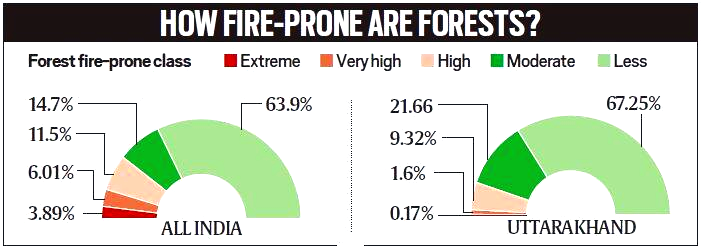Biodiversity & Environment
Forest Fires: A Very Big Concern
- 06 Apr 2021
- 6 min read
Why in News
Since the advent of the year 2021, there has been a series of forest fires in many states of India, including in Wildlife Sanctuaries.
Key Points
- Forest Fires:
- Also called bush or vegetation fire or wildfire, it can be described as any uncontrolled and non-prescribed combustion or burning of plants in a natural setting such as a forest, grassland, brush land or tundra, which consumes the natural fuels and spreads based on environmental conditions (e.g., wind, topography).
- Forest Fires can be incited by human actions, such as land clearing, extreme drought or in rare cases by lightning.
- There are three conditions that need to be present in order for a wildfire to burn: fuel, oxygen, and a heat source.
- Instances of Forest Fires in 2021:
- January saw prolonged fires in Uttarakhand, Himachal Pradesh (Kullu Valley) and Nagaland-Manipur border (Dzukou Valley).
- The Simlipal National Park in Odisha saw a major fire between February-end and early March.
- Recent fires also include those in Bandhavgarh Forest Reserve in Madhya Pradesh, and in sanctuaries for the Asiatic lion and the great Indian bustard in Gujarat.
- Vulnerability of India’s Forests to Fires:
- As of 2019, about 21.67% (7,12,249 sq km) of the country’s geographical area is identified as forest, according to the India State of Forest Report 2019 (ISFR) released by the Forest Survey of India (FSI), Dehradun.
- Tree cover makes up another 2.89% (95, 027 sq km).
- Based on previous fire incidents and records, forests of the Northeast and central India regions are the most vulnerable areas to forest fires.
- Forests in Assam, Mizoram and Tripura have been identified as ‘extremely prone’ to forest fire.
- States with large forest areas under the ‘very highly prone’ category include Andhra Pradesh, Manipur, Meghalaya, Mizoram, Nagaland, Odisha, Maharashtra, Bihar and Uttar Pradesh.
- As per the 2020-2021 annual report of the MoEFCC, Western Maharashtra, Southern Chhattisgarh and areas of Telangana and Andhra Pradesh, along with central Odisha, are turning into ‘extremely prone’ forest fire hotspots.
- Areas under the ‘highly prone’ and ‘moderately prone’ categories make up about 26.2% of the total forest cover — a whopping 1,72,374 sq km.
- As of 2019, about 21.67% (7,12,249 sq km) of the country’s geographical area is identified as forest, according to the India State of Forest Report 2019 (ISFR) released by the Forest Survey of India (FSI), Dehradun.
- Cause of Forest Fires:
- Forest fires can be caused by a number of natural causes, but many major fires in India are triggered mainly by human activities.
- Emerging studies link climate change to rising instances of fires globally, especially the massive fires of the Amazon forests in Brazil and in Australia in the last two years.
- Fires of longer duration, increasing intensity, higher frequency and highly inflammable nature are all being linked to climate change.
- In India, forest fires are most commonly reported during March and April, when the ground has large quantities of dry wood, logs, dead leaves, stumps, dry grass and weeds that can make forests easily go up in flames if there is a trigger.
- In Uttarakhand, the lack of soil moisture too is being seen as a key factor. In two consecutive monsoon seasons (2019 and 2020), rainfall has been deficient by 18% and 20% of the seasonal average, respectively.
- Most fires are man-made, sometimes even deliberately caused. For example, in Odisha, which saw a major fire last month in Simlipal forest, villagers are known to set dry leaves to fire in order to collect mahua flowers, which go into preparation of a local drink.
- Forest fires can be caused by a number of natural causes, but many major fires in India are triggered mainly by human activities.
- Impact of Forest Fire:
- Forest fires can have multiple adverse effects on the forest cover, soil, tree growth, vegetation, and the overall flora and fauna.
- Fires render several hectares of forest useless and leave behind ash, making it unfit for any vegetation growth.
- Heat generated during the fire destroys animal habitats.
- Soil quality decreases with the alteration in their compositions.
- Soil moisture and fertility, too, is affected.
- Forests can shrink in size.
- The trees that survive fire often remain stunted and growth is severely affected.
- Importance of Forests:
- Forests play an important role in mitigation and adaptation to climate change.
- They act as a sink, reservoir and source of carbon.
- A healthy forest stores and sequesters more carbon than any other terrestrial ecosystem.
- In India, with 1.70 lakh villages in close proximity to forests (Census 2011), the livelihood of several crores of people is dependent on fuelwood, bamboo, fodder, and small timber.
- Efforts to Mitigate Forest Fires:
- Since 2004, the FSI (Forest Survey of India) developed the Forest Fire Alert System to monitor forest fires in real time.
- National Action Plan on Forest Fires (NAPFF) 2018 and Forest Fire Prevention and Management Scheme.
- Since 2004, the FSI (Forest Survey of India) developed the Forest Fire Alert System to monitor forest fires in real time.





